您好,登錄后才能下訂單哦!
您好,登錄后才能下訂單哦!
本篇文章給大家分享的是有關SpringBean循環依賴問題的解決方法,小編覺得挺實用的,因此分享給大家學習,希望大家閱讀完這篇文章后可以有所收獲,話不多說,跟著小編一起來看看吧
示例:AService依賴BService; BService依賴AService
@Service
public class AService {
//
@Autowired
public BService bService;
}@Service
public class BService {
@Autowired
public AService aService;
}
Spring中的循環依賴問題在單例的情況下,Spring是已經幫我們解決好了,多例沒有解決循環依賴問題。
為啥,多例的情況下 Spring沒有去解決循環依賴問題?
因為在多例的情況下,設置的多例的對象沒有明確哪一個,就會產生循環依賴問題。
我們可以自己去:明確指定引用那個對象
@Service
@Scope("prototype")
public class AService {
// @Autowired
public BService bService;
// 為什么Aservice在創建的時候 為什么Bservice比ASERVICE 先創建
public AService() {
System.out.println("AService被Java的反射技術創建");
}
public void setbService(BService bService) {
this.bService = bService;
}
}@Service
@Scope("prototype")
public class BService {
// @Autowired
public AService aService;
public void setaService(AService aService) {
this.aService = aService;
}
}public class SpringApp {
public static void main(String[] args) {
// 1. ioc容器在創建的時候所有的單例對象是不是會被創建
AnnotationConfigApplicationContext applicationContext = new AnnotationConfigApplicationContext(MyConfig.class);
// // 對例子情況 當你在調用的時候才獲取
AService aSerivce = applicationContext.getBean("AService", AService.class);
BService bSerivce = applicationContext.getBean("BService", BService.class);
aSerivce.setbService(bSerivce);
bSerivce.setaService(aSerivce);
// 循環引用異常 找不到對象
/**
* 思考問題? 如果我們的項目對象必須要是多例? 而且必須要循環引用 明確的指定引用那個對象
*/
String[] beanDefinitionNames = applicationContext.getBeanDefinitionNames();
for (int i = 0; i < beanDefinitionNames.length; i++) {
System.out.println(beanDefinitionNames[i]);
}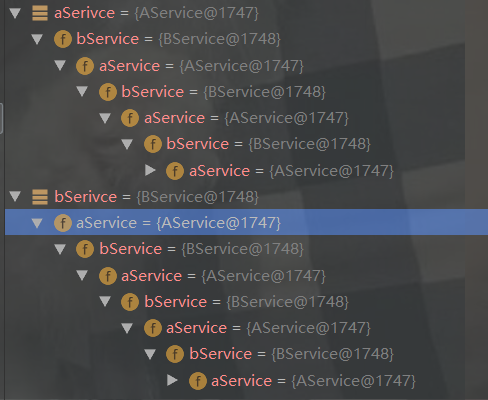
思考問題:單例對象在什么時候創建?
在IOC容器被創建的時候創建
多例的情況下,是在getbean()調用的情況下創建。多例對象每次用完就會去銷毀掉。
AnnotationConfigApplicationContext applicationContext = new AnnotationConfigApplicationContext(MyConfig.class);

// Instantiate all remaining (non-lazy-init) singletons. finishBeanFactoryInitialization(beanFactory);
// Instantiate all remaining (non-lazy-init) singletons. beanFactory.preInstantiateSingletons();
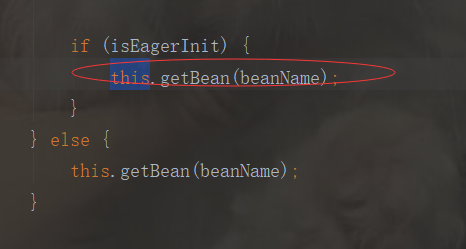
public Object getBean(String name) throws BeansException {
return this.doGetBean(name, (Class)null, (Object[])null, false);
}
public Object getSingleton(String beanName) {
return this.getSingleton(beanName, true);
}獲取緩存對象:
protected Object getSingleton(String beanName, boolean allowEarlyReference) {
Object singletonObject = this.singletonObjects.get(beanName); //根據BeanName去集合中查,查到就返回這個對象,【】【】【】一級緩存對象集合【】【】【】緩存完整對象【】【】完整對象表示對象已經創建完了,并且對象屬性已經賦值了。
if (singletonObject == null && this.isSingletonCurrentlyInCreation(beanName)) {
Map var4 = this.singletonObjects;
synchronized(this.singletonObjects) {
singletonObject = this.earlySingletonObjects.get(beanName); //查詢二級緩存中是否有緩存對象
if (singletonObject == null && allowEarlyReference) {
ObjectFactory<?> singletonFactory = (ObjectFactory)this.singletonFactories.get(beanName); //查詢三級緩存,三級緩存中有的化,將三級緩存中的數據放入二級緩存中
if (singletonFactory != null) {
singletonObject = singletonFactory.getObject();
this.earlySingletonObjects.put(beanName, singletonObject);
this.singletonFactories.remove(beanName);
}
}
}
}
return singletonObject;
}

一級緩存沒有找到,就去找二級緩存中找

singletonObject == null && this.isSingletonCurrentlyInCreation(beanName) //一級緩存沒有,并且singletonsCurrentlyInCreation判斷是否之前標記為該對象開始創建


if (isPrototypeCurrentlyInCreation(beanName)) { //我們對象是單例的,所有不進入
throw new BeanCurrentlyInCreationException(beanName);
}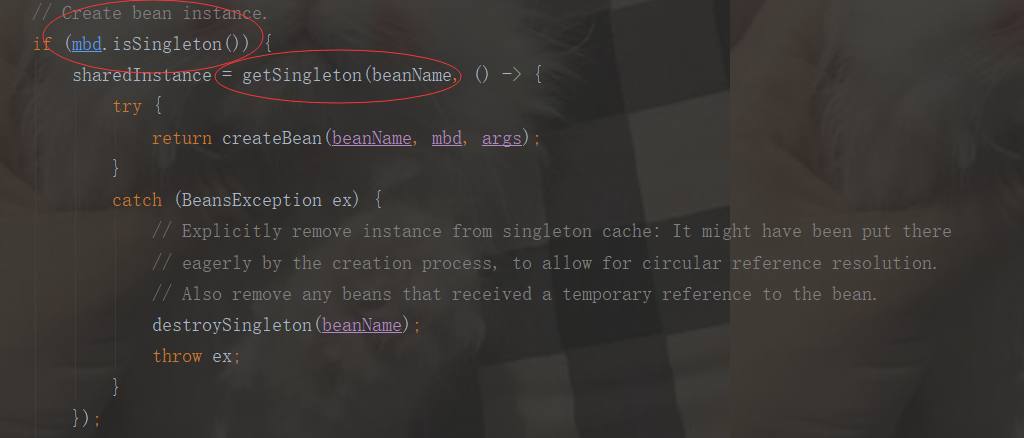
public Object getSingleton(String beanName, ObjectFactory<?> singletonFactory) {
Assert.notNull(beanName, "Bean name must not be null");
synchronized (this.singletonObjects) {
Object singletonObject = this.singletonObjects.get(beanName);
if (singletonObject == null) {
if (this.singletonsCurrentlyInDestruction) {
throw new BeanCreationNotAllowedException(beanName,
"Singleton bean creation not allowed while singletons of this factory are in destruction " +
"(Do not request a bean from a BeanFactory in a destroy method implementation!)");
}
if (logger.isDebugEnabled()) {
logger.debug("Creating shared instance of singleton bean '" + beanName + "'");
}
beforeSingletonCreation(beanName);
boolean newSingleton = false;
boolean recordSuppressedExceptions = (this.suppressedExceptions == null);
if (recordSuppressedExceptions) {
this.suppressedExceptions = new LinkedHashSet<>();
}
try {
singletonObject = singletonFactory.getObject();
newSingleton = true;
}
catch (IllegalStateException ex) {
// Has the singleton object implicitly appeared in the meantime ->
// if yes, proceed with it since the exception indicates that state.
singletonObject = this.singletonObjects.get(beanName);
if (singletonObject == null) {
throw ex;
}
}
catch (BeanCreationException ex) {
if (recordSuppressedExceptions) {
for (Exception suppressedException : this.suppressedExceptions) {
ex.addRelatedCause(suppressedException);
}
}
throw ex;
}
finally {
if (recordSuppressedExceptions) {
this.suppressedExceptions = null;
}
afterSingletonCreation(beanName);
}
if (newSingleton) {
addSingleton(beanName, singletonObject);
}
}
return singletonObject;
}
}
protected void beforeSingletonCreation(String beanName) {
if (!this.inCreationCheckExclusions.contains(beanName) && !this.singletonsCurrentlyInCreation.add(beanName)) {
throw new BeanCurrentlyInCreationException(beanName);
}
}標識為該對象開始創建

最終調用
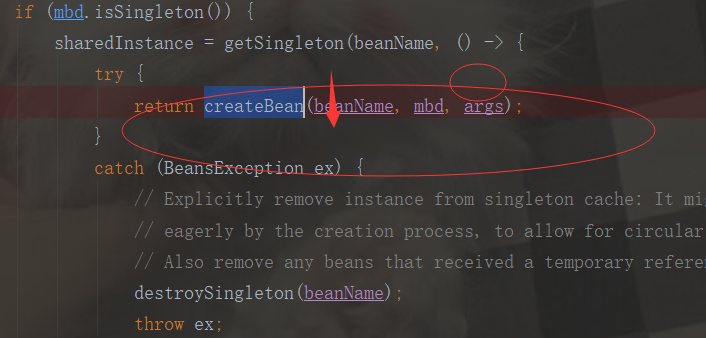
正真去創建我們的Bean對象:

既然要創建對象,先反射走無參構造函數,對象先實例化完成,在賦值

執行這個方法,輸出構造函數打印的語句,說明底層通過Java反射機制初始化的

在這之前,我們的對象屬于嬰兒對象,因為它的屬性還沒有賦值。都是稱為嬰兒對象。
那么什么時候賦值呢?

populateBean(beanName, mbd, instanceWrapper);//這里給對象屬性賦值
在給對象屬性賦值之前:
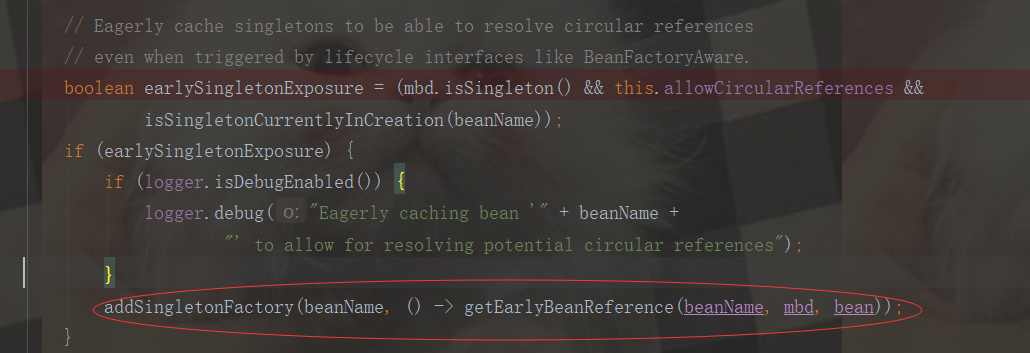
protected void addSingletonFactory(String beanName, ObjectFactory<?> singletonFactory) {
Assert.notNull(singletonFactory, "Singleton factory must not be null");
synchronized (this.singletonObjects) {
if (!this.singletonObjects.containsKey(beanName)) { //【】【】如果一級緩存沒有該對象的情況下,會將該對象存放在三級緩存中
this.singletonFactories.put(beanName, singletonFactory); //【】【】存放在三級緩存中,對象實例化完成,但是沒有賦值,嬰兒對象【】【】
this.earlySingletonObjects.remove(beanName);
this.registeredSingletons.add(beanName);
}
}
}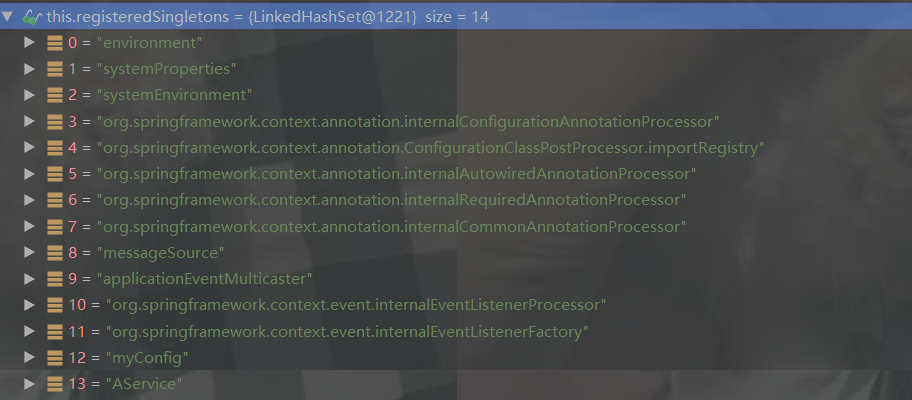

A對象堅持依賴B對象,這時候B對象也需要被創建
A對象已經存放在三級緩存中,這時候要去創建B對象
此時B對象也要走A對象流程

看下調用鏈
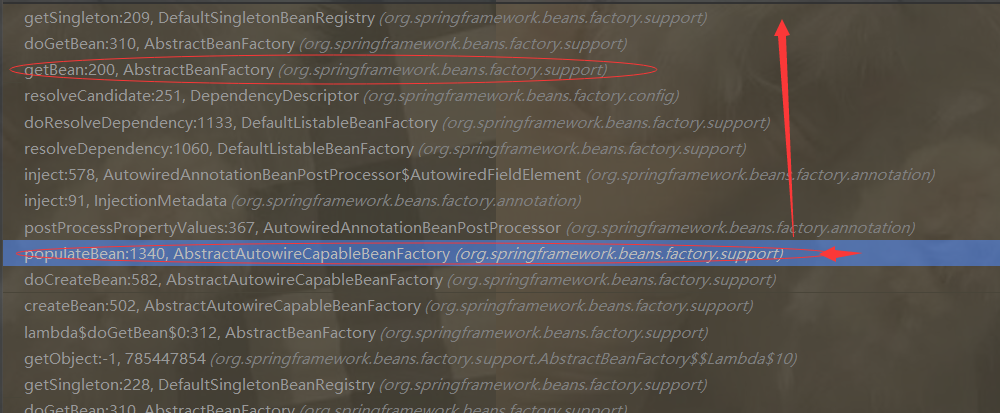


也將B對象放入三級緩存

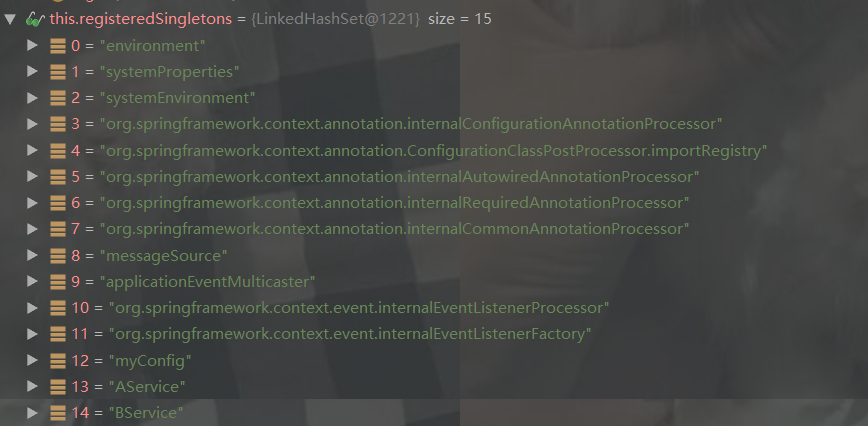
總結下:
AService在創建的時候,提前曝光存放到三級緩存中,AService發現依賴BService,這時候Bservice提前曝光存放到三級緩存中去。
此時BService又依賴AService,此時BService經過賦值是完整對象,但是Aservice還是嬰兒對象,沒有完全創建完畢。
就會去把BService對象注冊到一級緩存中,同時會把之前緩存BService對象的二級緩存清除掉
AService對象依賴BService,BService此時已經創建成功了,那么AService在設置屬性后,就直接把BService賦值給AService。
開始注冊AService對象


SpringBean中 Aservic對象被創建流程步驟源碼分析:
doGetBean創建我們bean對象
getSingleton (beanName) 獲取緩存對象
注意:完整對象概念:對象已經實例化成功并且所有屬性都已經賦值
singletonObjects 一級緩存完整對象
earlySingletonObjects 二級緩存 緩存嬰兒對象
singletonFactories 三級緩存存放嬰兒對象
理解概念:
完整對象表示該對象實例化完成并且所有的屬性已經賦值。
嬰兒對象(提前對象)對象已經實例化完成但是屬性沒有賦值的。
singletonObject ==null&&this.singletonsCurrentlyInCreation.contains(beanName);
{
才能夠查詢二級緩存
}
singletonsCurrentlyInCreation :標記為該對象開始創建
getSingleton(String beanName, ObjectFactory<?> singletonFactory)
this.singletonsCurrentlyInCreation.add(beanName) 表示該對象已經開始創建
createBean() →doCreateBean
addSingletonFactory 將嬰兒對象(不完整對象也就是只是實例化完成但是屬性沒有賦值的) 存放三級緩存中。
A對象已經存放到三級緩存中,開始給對象屬性賦值的時候 需要創建B對象。
A對象檢查發現依賴B對象 這時候B對象也需要被創建
以上就是SpringBean循環依賴問題的解決方法,小編相信有部分知識點可能是我們日常工作會見到或用到的。希望你能通過這篇文章學到更多知識。更多詳情敬請關注億速云行業資訊頻道。
免責聲明:本站發布的內容(圖片、視頻和文字)以原創、轉載和分享為主,文章觀點不代表本網站立場,如果涉及侵權請聯系站長郵箱:is@yisu.com進行舉報,并提供相關證據,一經查實,將立刻刪除涉嫌侵權內容。